Courtesy: Connor Bradley (@cobrastats on X)
The 2021 Olympics in Tokyo marked the first time the USA had finished outside of the top two in a 400 medley relay at the Olympic Games. They finished 5th in the inaugural mixed 400 medley relay.
Let’s be honest, the mixed medley is a different animal. It’s not as easy to piece together as a non-mixed 400 medley. Those tend to be pretty simple: take your highest-seeded or fastest swimmer in each stroke 100m, put them together, and voila – you got a relay.
But with six different ways to order the genders, and multiple athletes per stroke, the Tokyo coaching staff was staring into the face of thousands of combinations of athletes (though some much better than others). And while the lineup the USA fielded behind the blocks for the Olympic final was strong, it left several people scratching their heads after finishing two spots off the podium.
Being an armchair coach with hindsight that’s 20/20, it’s easy to criticize the USA staff’s decisions. And it’s clear that the coaches labored over the decision and weren’t just picking names from a hat. Coach Greg Meehan talked through the process after the relay back in Tokyo:
“There’s a lot of math that goes into some of those decisions, but there’s also some environmental circumstances that we’re looking at: Who we’re swimming next to, where we’re swimming in heats, where we’re swimming — knock on wood — potentially, into the finals, how our athletes are moving through the front half of the meet,” Meehan said.
“So, there’s that and looking at the event orders at those particular sessions and making sure that we’re prepping people or we’re swimming people in the right way that’s not impacting their individual swims but also helping us as Team USA win a gold medal.”
Or another way Meehan put it, it’s “mathematics” versus using “gut instinct”.
On the outside, spectators aren’t privy to some of those behind-the-scenes factors that coaches see. But I’m a numbers guy and I’ve got what I got. Therefore, within a vacuum, what do the numbers say about Tokyo, the USA’s strategy heading into Paris, and the mixed medley relay strategy as a whole? Let’s dive into the data.
THE MIXED 400 MEDLEY RELAY
There’s a bit of a luxury with the mixed 400 medley relay and that is – for a country like the USA – you’ve got basically your entire (up to) 52-athlete roster to work with. You’ve got options upon options.
At the same time, all else equal, the mixed medley is a math problem, and a fairly straightforward one: in which two legs does your team give up the least amount of time switching from a male swimmer to a female swimmer? Or a different way of saying it – where have female swimmers closed the gap the most?
I come from an economics background, and a key concept that comes up early in Economics 101 courses with regards to decision-making is maximizing your benefit. First too, understand that every decision has a trade-off (opportunity cost). Here’s the basic idea: when making a decision, you weigh the additional benefit (what you gain) versus the additional cost (what you give up). If you gain more than what you’re giving up, it’s a worthwhile decision. If you give up more than what you gain, not a great decision. When do you stop? When there are no more decisions you can make where the additional benefit outweighs the additional cost. And at that point, you’ve maximized your benefit.
This can be applied especially in the mixed medley relay – but here, our benefit is how fast we go. Looking back at Tokyo, the U.S. went with a male-female-female-male lineup – the only ones in the field to do so. Post-Tokyo, there was talk of “the USA should have had a male breaststroker because everyone else did.” I’d argue that yes – they should have, but no – not because it’s what everyone else was doing. And I feel pretty strongly about this – it’s not what the field is doing or what genders they put where; it’s what kind of lineup your country can piece together regardless of what everyone else is doing. As we’ll see, there were areas where the U.S. could have made gains in net benefit (time) by switching some athletes around in Tokyo.
You can see the thinking behind always having a male breaststroker and (and also a female freestyler) if you think about differences in 100m times between men and women as a percentage of the time and not a fixed amount of time. The table below shows the average best time of the top 200 swimmers in the world this year.
When you compare the times, the percentage difference in time between men and women across all strokes is about the same. But really narrowing it down, breaststroke does technically have the smallest percentage difference. However, since breaststroke is the slowest of the four disciplines, this ends up representing the largest time margin (on average) between male and female swimmers. Then, butterfly and backstroke are about the same, with freestyle having the smallest time difference (since it is the fastest stroke). It’s quite a generalization to say that always, every single time, use a male breaststroker and a female freestyler. It depends on what athletes a country has available to them.
Once again, getting into the numbers, all else is held equal for this analysis. There are many other factors at play: meet schedule, athlete schedule, other swims that day, regression/improvement heading into meet, etc. But raw numbers here: where does your team give up the least amount of time switching from a male swimmer to a female swimmer?
TOKYO
For this analysis, I pulled two main sets of data:
- A list of all entrants at the 2020 Tokyo Olympic Games
- A list of the top 200 fastest swimmers in each stroke 100m (both men and women) dating back to January 1, 2021, up through July 31, 2021 (just before the mixed medley in Tokyo).
Basically, this gives you all your relatively fast swimmers in each event who are present at the games. We’ll focus in on the fastest American men and women in each 100m discipline.
But once again, the question is: where does the team give up the least amount of time?
According to this, from Ryan Murphy to Regan Smith, the USA was 5.67 seconds slower, from Michael Andrew to Lilly King, 6.58 seconds slower, and so on. The USA gave up the most time in the breaststroke and butterfly legs and the least in backstroke and freestyle.
Back to our cost/benefit analysis. With the MFFM lineup the U.S. chose, what would be the net benefit of switching the male and female swimmers on backstroke and breaststroke? The numbers say the gain from that is getting 6.58 seconds on the breaststroke leg, but that comes at a cost of getting 5.67 seconds slower on the backstroke leg. But since the additional benefit outweighs the additional cost (by 0.91 seconds) – it would seem like a good decision. The same goes for butterfly and freestyle, with the benefit outweighing the cost by 0.24 seconds
Therefore, the USA’s best projected time would come by employing a FMMF lineup. However, the U.S. opted for a Ryan Murphy, Lydia Jacoby, Torri Huske, and Caeleb Dressel lineup. But there was a lot else at play (remember, our analysis is in a vacuum). For one, Abbey Weitzeil and Simone Manuel were coming off the 50 free 11 minutes earlier, which already took away the top two female options for freestyle. Not to mention anything and everything else the coaches had been seeing or hearing from athletes to that point of the meet.
As mentioned before, there were thousands of relay options. I ran every possible relay option for the U.S. at the 2020 Olympics using the criteria outlined above, and it spit out over 10,800 relay options available to the U.S. in Tokyo. The lineup the U.S. chose to go with ranked 83rd by about 1.4 seconds.
It was regularly brought up that the U.S. was the only country to go with a female breaststroker. Of the full list of USA options for the Tokyo games, only 1 in the top 25 and three in the top 50 lineups had a female breaststroker. And once again, this is not at all a knock on any of the female breaststrokers. It just means that the gap between the male and female swimmers in the USA was smaller in the other three strokes.
And while the U.S. certainly has more depth than other countries, the four teams that beat the United States (highlighted above) used the lineup that was their top-projected lineup. Again, could have been a bit more clear-cut for some of those countries, but swim fans were saying the same of the USA.
But as the coaches said, lessons were learned. It’s an easy thing to overthink with so many options and different lineups being within hundredths of seconds of one another. But sometimes, it’s better to let the numbers talk for themselves than try to talk for the numbers.
PARIS
Once again, I pulled two main sets of data:
- A list of all entrants at the 2024 Paris Olympic Games
- A list of the top 200 fastest swimmers in each stroke 100m (both men and women) dating back to January 1, 2024, up through July 31 (the day this was written; after finals).
Some things are the same, while some are different for the USA heading into the Paris games.
The same? Smith and Murphy still sit atop the throne for USA backstroke. However, from the Tokyo lead-up to the Paris lead-up, Murphy has improved by 0.15 while Smith has improved by 0.73. This means that the gap has gotten even smaller at the top for the US.
Different? Gretchen Walsh’s world record in the 100 butterfly at team trials (along with Dressel’s Olympic-cycle best 50.19) means the gap between top butterfliers in the U.S. has shrunk from 6.21 seconds to 4.99 seconds.
So, while last Olympics it was fairly clear the U.S. should swim its top female swimmers at backstroke and freestyle, it now seems that the US’s best move is to swim its top male swimmers at breaststroke and freestyle while slotting in female swimmers at backstroke and butterfly. Considering Smith and Walsh set the world records in those respective events just over a month ago, it makes sense that those two would close the gap on the USA’s male swimmers in those races.
One reason this plays into the USA’s strengths is the schedule for that day – August 3.
- The morning consists of heats for both men’s and women’s medley relays. We’ll likely see some more #2 swimmers in the morning.
- Morning has women’s 50m freestyle heats with semifinals in the evening. But based on the current timeline, Walsh would have almost an hour between her 50m semifinal and the mixed 400 medley final.
- As of right now, looking at the top relay option, only Gretchen Walsh would have any other (required) swim the day of the mixed medley final.
Now the big question – where does this compare to the rest of the world heading into Paris?
Likely, the two biggest challengers to the U.S. are China and Australia. What’s interesting about the projected podium is that none of the three share the same order of athletes – with the Chinese projecting to end their relay with females while the Australians may look to bookend the race with female swimmers. Let’s take a quick look at both of these team’s lineups
CHINA: NO PAN ZHANLE?
On Wednesday, Pan Zhanle ripped a 46.40 world record in the 100m freestyle. But China’s best projected mixed medley relay leaves him on the bench. How is that? Once again, it’s a math problem.
For China on the women’s side, Wan Letian has been a 59.02 in the women’s 100m backstroke back in April. However, Xu Jiayu‘s 52.02 early in the Games gives him the fastest time this year and a 7-second advantage over Wan. Additionally, as is true with many countries, the breaststroke gap is too big to ignore. Therefore, if China opts to go with men in both the back and breast, they have no choice but to leave Pan off the relay.
Even if you look at just the best swims so far in Paris – even without full 100m butterfly information, this is still the case. In fact, narrowing the focus to just Paris further makes the argument that the Chinese mixed medley relay is better off without Pan Zhanle anchoring. Which feels like a crazy thing to say.
Or you could think of it this way: suppose Wang Changhao ties his best with a 51.20 in the 100m fly. With the best-projected, Pan-less MMFF lineup, adding Pan to the relay would help China get 6.08 seconds faster. However, that would force them to switch out one of the other men for a woman – likely in the breaststroke. Therefore, in getting 6.61 seconds slower on the breaststroke leg, China would see a net change of -0.53 seconds.
AUSTRALIA: AUSSIE OPTIONS?
Looking through what the Australians have available to them, it seems pretty clear what they should do.
It’s worth noting, all 10 of the lineups seen here for Australia are FMMF. In fact, you’ll have to go 1.2 seconds and 18 options back to find a different order.
Additionally, you’ll notice some trends throughout. First of all, former world record holder in the women’s 100m backstroke Kaylee McKeown seems to be the best options for the Aussies leading off. Sam Williamson has been sub-59 twice this year in the 100m breaststroke while Matthew Temple has been sub-51 twice this year in the 100m butterfly.
Then comes the female freestyle leg. While Mollie O’Callaghan has the fastest flat 100m freestyle, both Meg Harris and Emma McKeon split a 51.94 with a relay exchange in the 4×100 freestyle relay early in the week. The Aussies have options there.
SO WHAT’S THE BEST OPTION FOR THE USA?
I don’t know. That’s the thing – all this analysis has been in a vacuum, but that’s not the reality that the USA staff is dealing with.
That’s then where the coaches’ have to start weighing all of those other factors at play. It would seem silly to leave Torri Huske off of the relay at this point. She won the 100 fly and has the fastest flat 100 free by an American woman this year. Most everyone has been a tad bit slower this week, so who do you trust on relays? Illness has been going around the team, how’s everyone feeling? How’s fatigue nearly a week into the meet? There’s a lot to consider.
Limiting the best 100m performances to just this week (at the time this is written, we are still waiting on the men’s 100 fly), there are options. Hypothetically (in a this-past-week vacuum), if Dressel can be 50.10 or faster, you go with a FMMF relay of Regan Smith, Nic Fink, Caeleb Dressel, and Huske. If he’s a bit slower, you go MMFF with Ryan Murphy, Nic Fink, Gretchen Walsh, and Huske. But if you go based on best times in 2024, you go FMFM with Smith, Fink, Walsh, and Jack Alexy.
The U.S. does have three options – FMFM, FMMF, and MMFF – that all project to within three-tenths of a second of one another. The commonality? A male breaststroker. So, it seems that as long as you slot in a male at breaststroke, you can’t go wrong. And that feels like a luxury this deep into the week.
Sometimes, crunching the numbers is fun, and often it’s incredibly helpful. But lineup decisions are above my pay grade, and I’m grateful for that. Therefore, I’ll stick to screaming my head off for the USA no matter what.
If you want to check out the thousands of relay possibilities for not just the USA, but other teams as well, check out this Google Sheet.
If you like R, you can get all the code and data on my GitHub [https://github.com/cobrastats/mixedmedley]
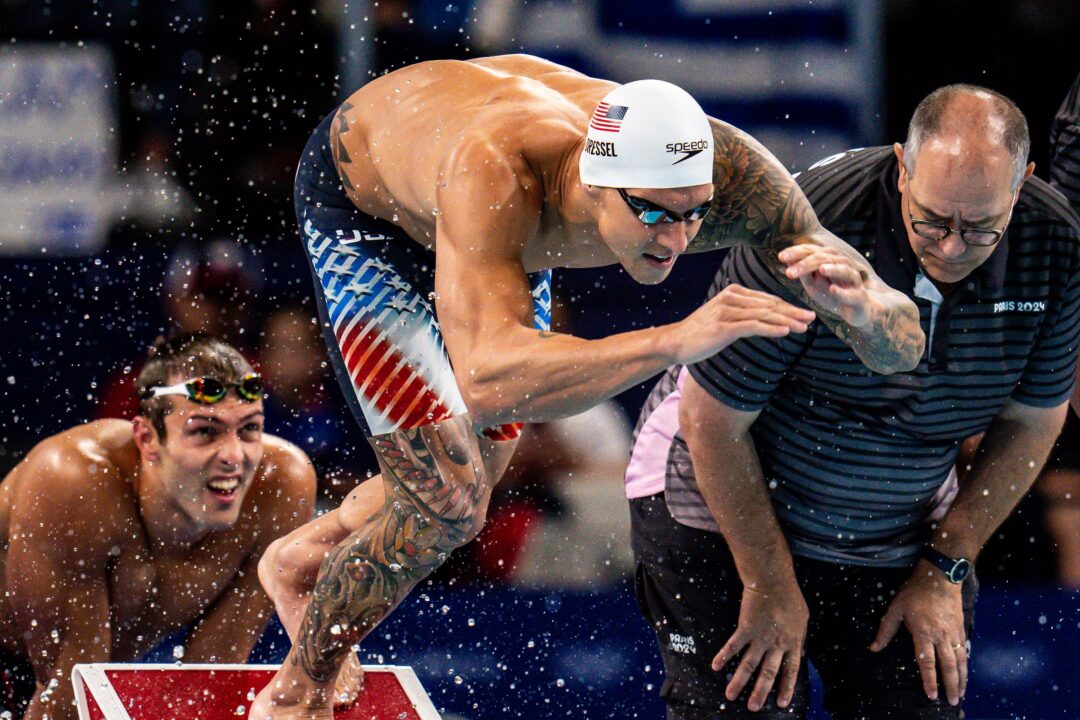
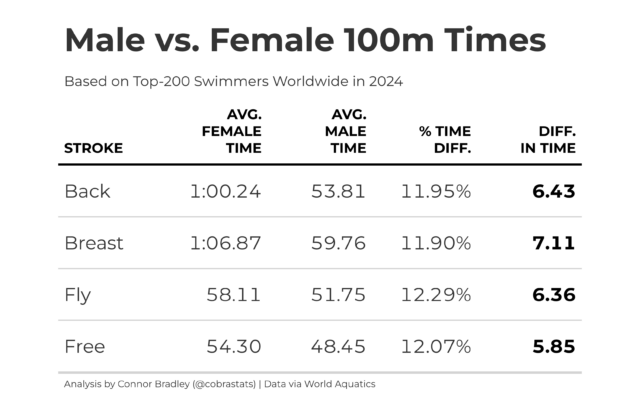
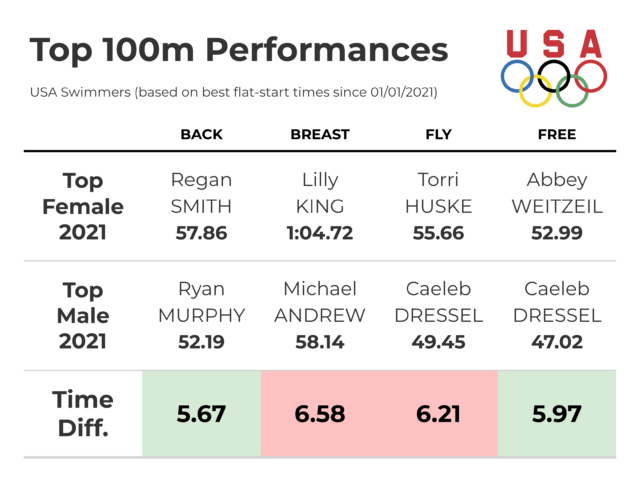
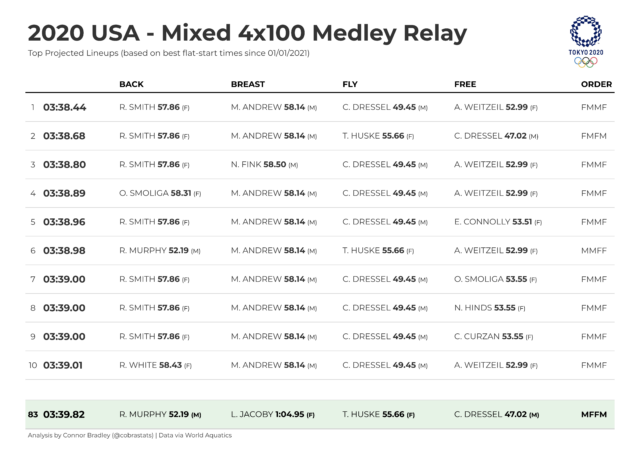
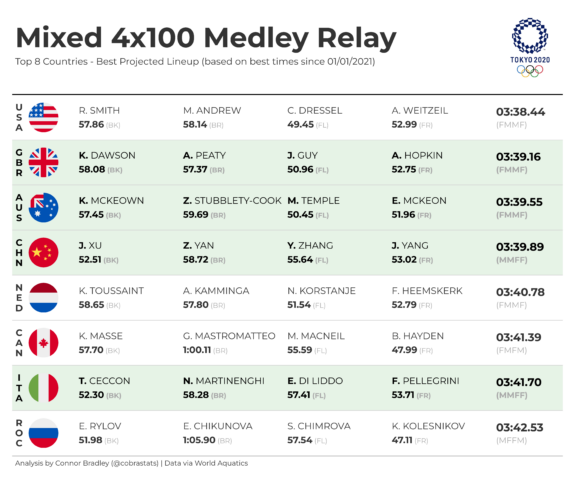
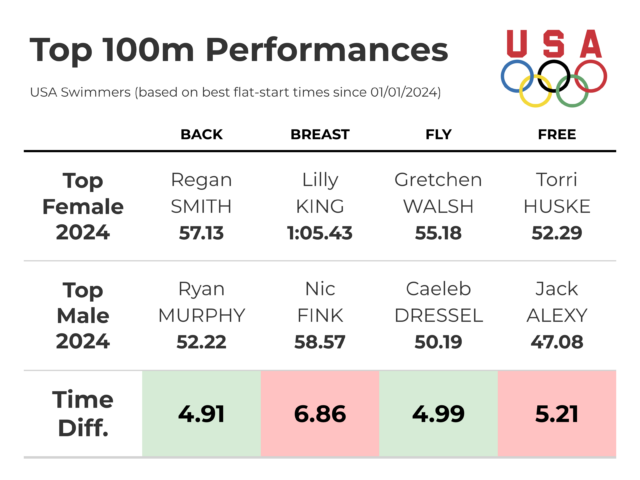
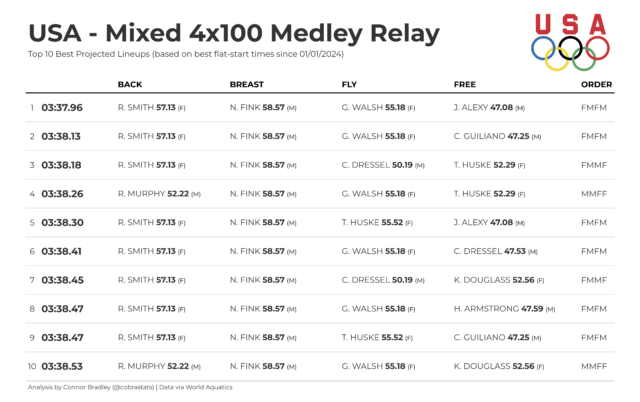
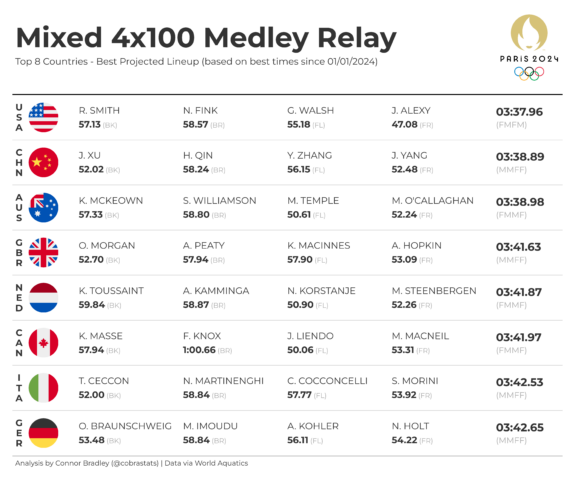
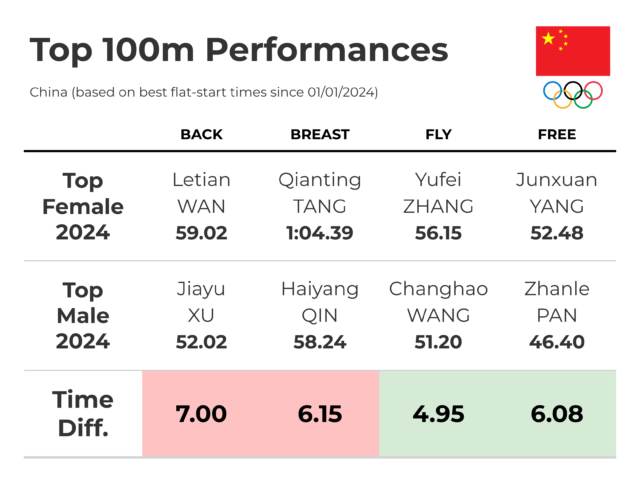
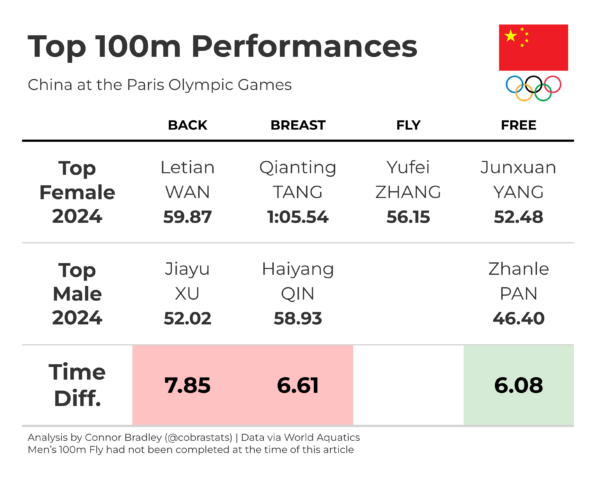
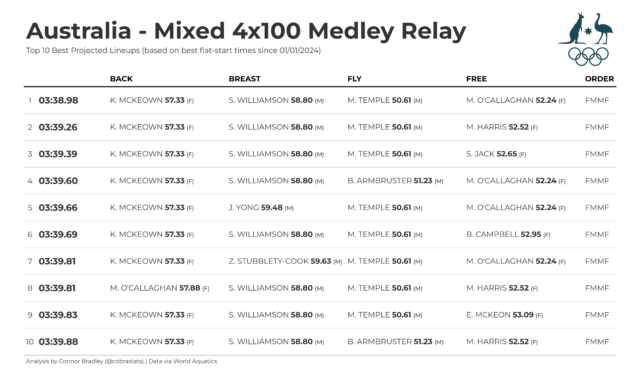
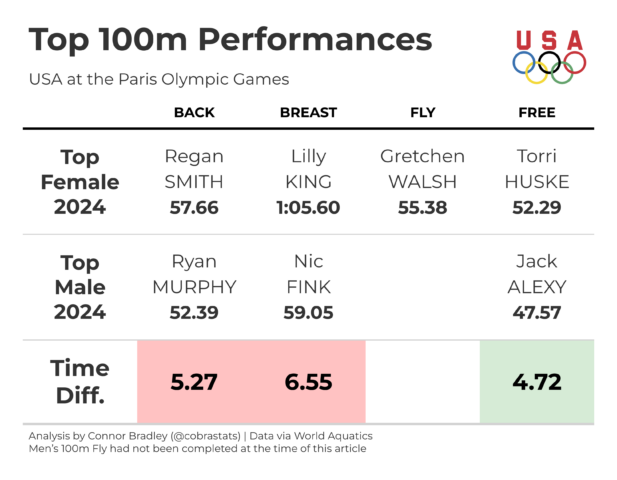
Your 5th ranked for Australia was their line-up, K. McKeown, J. Yong, M. Temple, M. O’Callaghan, giving them Bronze.
Your choices for China were true but all in different strokes, Y. Zhang, J. Xu, J. Yang, H. Qin, giving them Silver.
Your 4th ranked for the USA was true but most in different strokes, N. Fink, G. Walsh, R. Murphy, T. Huske, giving them Gold.
Connor, email me please. I’m teaching a math class with a unit on probability and like to incorporate your article.
Essentially, you would nearly always be better off putting the male swimmers on the Breast and Fly legs, because those strokes benefit from greater power output. It’s simple physiology.
The schedule hurts Australia the most – by far. All of their fastest lineups have McKeown swimming back, but she will have the 200 IM final about 30 minutes beforehand, and a *possible* medal ceremony just minutes before. They will probably still try it, especially because they did not have a male backstroker make even the semi-finals of the 100, but that’s a tough double, especially putting her between 2 male backstrokers.
I’m very curious what the lineup will be for both prelims and finals. For finals, I haven’t seen anyone note that probably 3 swimmers will have swims less than an hour beforehand, in this order: Dressel (100 fly final), Walsh (50 free semi), and Douglass (200 IM final). I also agree with others about consideration of the waves. Looking forward to this and the other medley relays!
I’m also curious how the women’s medley relay will turn out with Huske doing so well in the 100 free. Will she swim fly in the prelims and free in the final? Does her 100 fly win (by 0.04) count her in for swimming fly instead, even though the overall time may be… Read more »
I’m very curious what the lineup will be for both prelims and finals. For finals, I haven’t seen anyone note that probably 3 swimmers will have swims less than an hour beforehand, in this order: Dressel (100 fly final), Walsh (50 free semi), and Douglass (200 IM final). I also agree with others about consideration of the waves. Looking forward to this and the other medley relays!
I’m also curious how the women’s medley relay will turn out with Huske doing so well in the 100 free. Will she swim fly in the prelims and free in the final? Does her 100 fly win (by 0.04) count her in for swimming fly instead, even though the overall time may… Read more »
Just for fun I will go with R. Smith (back), N Fink (breast), Dressler (fly), Huske (free) as the mixed medley quartet.
This is a really interesting article, thanks for doing this. I think it’s really cool to see how much Regan Smith and Gretchen Walsh have closed the gap, and people have always said they want to see what Gretchen could do up against men. Her underwaters have significantly closed that gap and I feel like it would be a good move to put her (or Torri) on the fly leg. If Kate Douglass will be fresher, maybe have her do the free leg.
I do think France is an underdog in male and mixed medley’s relays